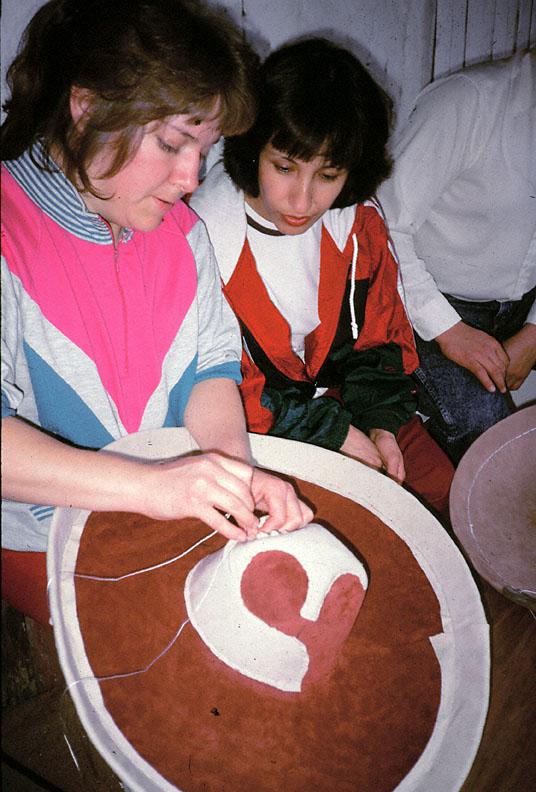- Catalog No. —
- S 2-1463
- Date —
- 1995
- Era —
- 1981-Present (Recent Oregon History)
- Themes —
- Arts, Folklife, Race, Ethnicity, and Nationality
- Credits —
- Oregon Historical Society Folklife Program
- Regions —
- Northeast
- Author —
- Barry Peril
Charro Sombreros
This photograph, taken by Barry Peril in 1995, shows Norma Mendoza (right) looking on as Maria Guadalupe Barajas (left) demonstrates a sewing technique used to decorate a traditional charro sombrero. The two women worked together through the Traditional Arts Apprenticeship Program of the Oregon Historical Society Folklife Program in 1994.
Maria Guadalupe Barajas was born in Mexico City in 1965. When “Lupe” was eleven years old, her mother began teaching her the family trade of creating elaborate charro sombreros. Charro sombreros are large-brimmed hats―typically adorned with elaborate embroidery and decorative patterns―worn by Mexican rodeo cowboys and mariachis. In addition to making sombreros, Barajas also makes other charro accouterments, such as embroidered vests, shirts, and fitted trousers. Today, Barajas lives in Hermiston, Oregon, where she and her husband, Emilio Zapata, continue to carry on their charro heritage.
While the historical roots of charrería can be traced to sixteenth-century Spain, the specific equestrian traditions celebrated in modern-day charreadas, often called “Mexican rodeos”, were born in North America. In Mexico, vaqueros, sometimes referred to as “Mexican cowboys”, adapted their Spanish traditions and equipment to manage large, feral herds of cattle and horses in an arid environment. Over time, efforts by wealthy landowners to emulate Spanish fashions led to the popularity of increasingly ornate costumes among all classes of Mexico’s horsemen. By the early seventeenth century, Mexico’s dapper horsemen were derisively referred to as charro by the colonial aristocracy―a term that implied inappropriate and improper showiness. But, this derogatory connotation was short-lived, and over the following centuries, as charros played important roles in war and politics, they became an enduring symbol of Mexico’s national identity.
Today, charreadas take place throughout Mexico on a regular basis and are typically credited as Mexico’s most popular sporting event. Mexican-American communities put on charreadas as well―particularly in the American West. In the United States, participation in charrería, through performance or attendance, has become important in the preservation of Mexican heritage on foreign soil.
Further Reading:
Sands, Kathleen Mullen. Charrería Mexicana: An Equestrian Folk Tradition. Tucson, Ariz., 1993.
Written by Joshua Binus, © Oregon Historical Society, 2005
